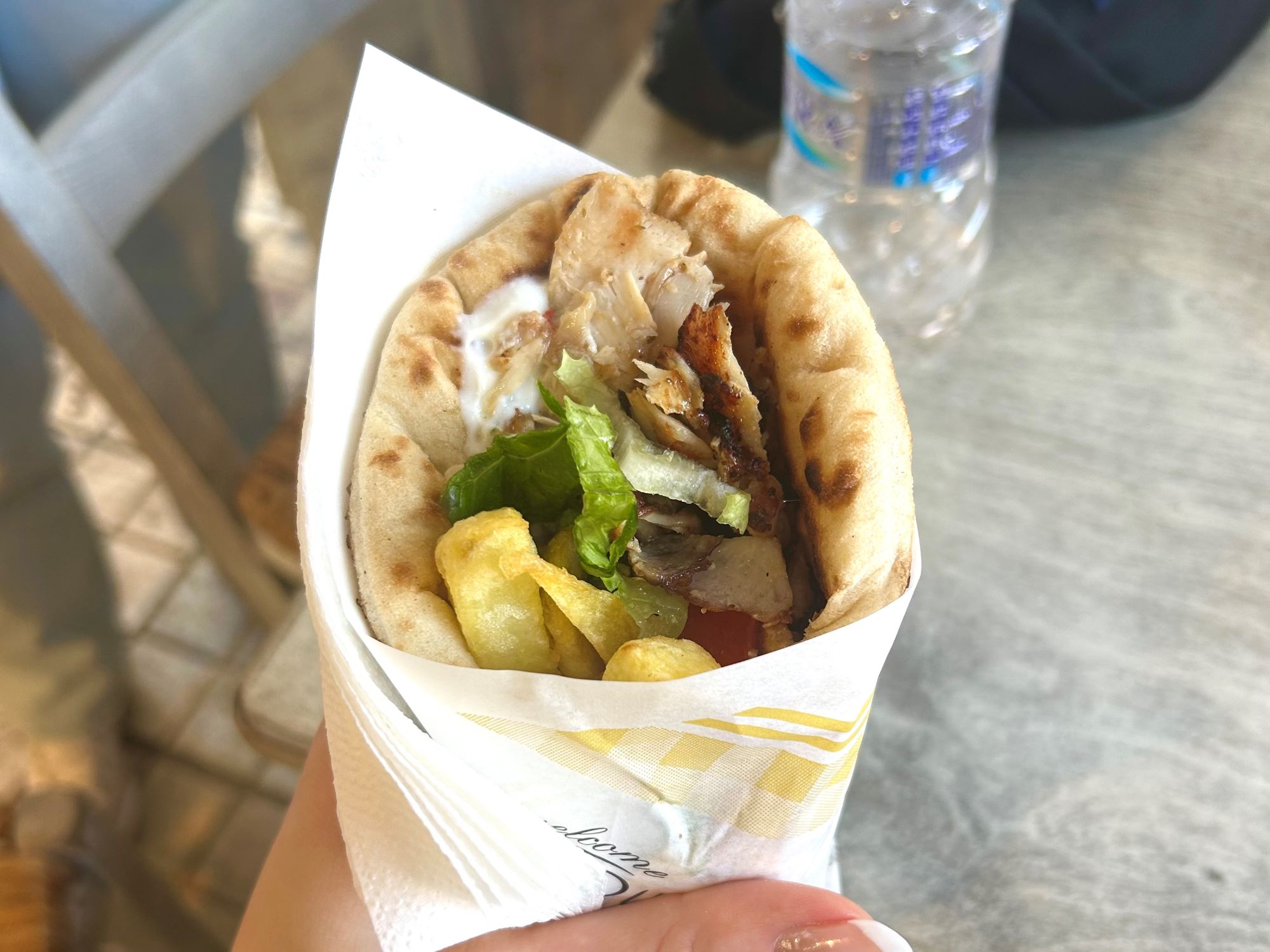Food is a key factor in any travel experience, and while some globetrotters enjoy immersing themselves in local flavors, others may feel intimidated by the uncertainty of what they’ll find in a new culture. For me, I land somewhere in the middle, and upon returning from my recent trip to Greece, I was pleasantly surprised by the tastiness of the Mediterranean diet. Not only is the cuisine flavorful and fresh, but many of the staple dishes are similar to comfort foods in the U.S., contributing a sense of familiarity to each meal.
From hearty dinners to decadent desserts, come explore these eight traditional foods every traveler should try when visiting Greece.
Pastitio
Baked pasta is a tried and true, and you can’t go wrong with this Greek version either. Similar to lasagna or mostaccioli, pastitio is a base layer of pasta noodles and ground meat, topped with a creamy béchamel sauce. The meal is cooked in a circular dish, and the béchamel is toasted to a perfect golden-brown crust for a little extra crispiness. Sounds delicious, right?
Travelers interested in trying pastitio for themselves should note that the dish is rather “heavy,” as the creaminess of the béchamel paired with the dense nature of pasta makes it quite filling.
Baklava
This dessert has been a Greek classic since the 16th century when the Ottoman Empire was established. Baklava is traditionally served during festivals, celebrations and other family gatherings, especially around Easter and Christmas time, though visitors will be able to find the dessert in some Greek cafés year-round.
The treat starts with layers of phyllo dough, and when baked, gives baklava a light, flaky texture. In the middle, a generous portion of crushed walnuts or pistachios — sometimes a mix of both — is seasoned with sugar and ground cinnamon. The nutty layer is then finished off with a sweet syrup made from water, sugar, vanilla extract and honey. On top is the final layer of phyllo dough brushed with melted butter.
This dessert has already achieved melt-in-your-mouth status, but baklava that uses locally sourced honey is on a whole other level of delicious. Surprisingly, Greece is one of the largest producers of honey in the EU, so dishes that incorporate this delicacy have an enhanced sweetness you simply can’t replicate.
Souvlaki

At first glance, souvlaki is the Greek equivalent of a kebab. It’s made with chicken, pork, lamb or beef, and the meat is seasoned with lemon juice, olive oil, oregano and garlic. Then, throw it on the grill and serve it up on a platter with vegetables, pita bread and tzatziki. It sounds simple and rather unoriginal, but the end product is the juiciest, most flavorful meat you’ve likely ever tried — it’s really that good. Souvlaki is a common fast-food item in Greece and can be found at almost any street vendor stand. It’s reasonably priced, filling and the perfect meal for on-the-go traveling.
Soutzoukakia
Originating from Smyrna — now known as Izmir, Turkey — soutzoukakia is a football-shaped meatball. The dish is typically made from ground beef, onions, garlic and fresh herbs, though what makes soutzoukakia unique is the shining star spice combination of cumin and cinnamon. Once prepped, the meat soaks in a flavorful tomato sauce and is usually served with potatoes, though rice, mashed potatoes or salad are other common alternatives. The comforting aroma of cumin combined with a meat-and-potatoes-centric dish makes it the ideal option for a cozy winter meal.
While soutzoukakia is one version of a meatball dish in Greece, travelers can also opt for a similar meal of keftedes. The ground meat in this one tends to be less seasoned and is often served with tzatziki instead of a rich tomato sauce.
Loukoumades
A dessert crossover between donut holes and funnel cake? Yes, please! Loukoumades may take the circular shape of the beloved Munchkin, but its crispy outer layer reveals a light, doughy texture on the inside. Traditionally, loukoumades are doused in honey and lathered with cinnamon, sometimes garnished with chopped nuts. However, companies like Lukumades, which have storefronts all throughout Athens, will offer even sweeter variations of this dessert by drenching the dough balls in chocolate sauces, complete with a scoop of ice cream and other toppings.
Similar to other Greek desserts, loukoumades is another popular item during the holidays, especially Christmas, New Year’s Eve or other family celebrations. Travelers interested in indulging should come hungry because, despite the dessert’s airy appearance, loukoumades will fill up the stomach quickly.
Fava
One major misconception about Greek cuisine is the inclusion of hummus. While it’s generally thought that hummus originated in Greece, the country’s proximity and trade routes with the Middle East, where the dish is far more popular, is likely where the myth stems from.
Instead, fava is the long-lost sister of this creamy dip. Depending on who is preparing the fava, it’s made from either yellow split peas or grass pea seeds. In either variation, the fava has a much more subtle flavor compared to hummus, as it doesn’t use any tahini. The peas are transformed into a mash and lightly seasoned, where the final product is topped off with chopped onions and a healthy dose of olive oil. Fava is served with bread and sometimes olives or cheese.
Gyro

A classic Greek staple, I would be remiss if I didn’t recommend travelers grab an authentic gyro for themselves when visiting; they are exceptionally tastier and fresher than anything you may find in the U.S.!
Before embarking on a hunt for a lamb gyro, visitors should be aware that their search will likely only turn up chicken and pork options — this is another Greek cuisine misconception. Lamb is a seasonal meat in Greece, with its demand peaking in springtime (thank you, Easter), and it’s much more cost-effective for restaurants and shops to substitute the meat with chicken or pork.
Travelers will find that the ingredients are similar to what appears on gyros in the U.S., with the shaved meat sitting in a warm slice of pita bread, garnished with tzatziki, tomato, lettuce and, oddly enough, French fries on occasion.
The gyro may sound identical to the preparation of souvlaki, but the meat here is pulled off a vertical rotisserie opposed to grilled, which is the key difference between these two dishes.
Gigantes Plaki
This might seem like a stretch for some, but this dish features giant white beans, typically fasolia gigantes, baked in a tomato sauce. The word “plaki” will appear frequently in Greek cuisine, and it simply refers to the cooking method where the food is roasted in tomatoes, veggies and extra virgin olive oil. Don’t sell this dish short as only a bowl of roasted beans and vegetables — the flavors come together in perfect harmony to create a top-tier savory meal.
Before You Go …
Travelers should note that Greece is big on tavernes, or taverns. These small establishments specialize in traditional dishes, many offering a combination of the foods described above. Additionally, the mezze serving style is common, where a variety of large appetizers are shared amongst the table. Guests will frequently see variations of Greek salad, fava, fried zucchini, tzatziki and potatoes here.
Remember that Greek cuisine isn’t spicy, but instead relies on the inclusion of oregano, thyme and mint. Pulling flavor from the green herbs is a priority to enhance the taste of their food. Feta, made from a mix of goat and sheep milk, is a common addition to dishes, and olive oil is essential in Greek cooking — don’t be surprised to find these ingredients in most of the traditional foods.






comments